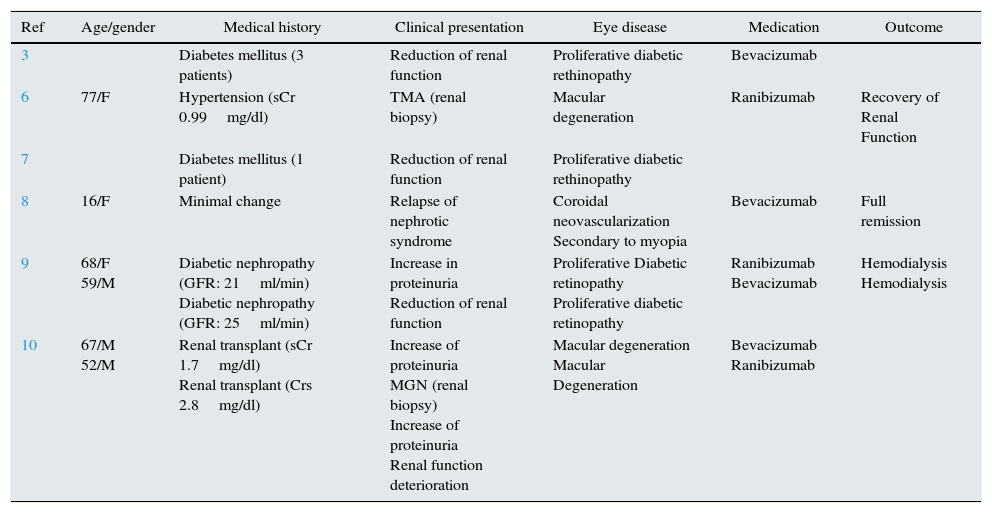Vascular endothelial growth factor (VEGF) promotes angiogenesis and is being produce by several types of tumors. The production of VEGF by tumors is related to aggressiveness, growth and their capabilities to produce metastasis and relapse. Inhibitors of angiogenesis (anti-VEGF) are effective therapeutic options for the treatment of patients with metastatic tumors. They are generally well-tolerated drugs, but the increase in use has shown secondary effects including at the renal level.1,2
Recently, the intravitreal use of this type of antiangiogenic therapies has been a revolution in the field of Ophthalmology.3,4 Age-related macular degeneration, diabetic macular edema, or macular edema secondary to retinal vein occlusion are some of the entities that have been most frequently benefited from the use of anti-VEGF. However, there is little information on the renal adverse effects of these drugs when administered intraocularly.
We describe the case of a patient with chronic kidney disease secondary to diabetic nephropathy who presented impaired renal function and increased proteinuria following the administration of several doses of ranibizumab for the treatment of diabetic retinopathy.
The patient is 56-year-old male, obese, smoker, and diagnosed of type 2 diabetes mellitus with good glycemic control (glycated hemoglobin ≤7% total Hb) on insulin therapy. The patient had severe proliferative diabetic retinopathy with significant decrease in visual acuity and chronic renal failure secondary to biopsy proven diabetic nephropathy (Class IV diabetic glomerulosclerosis). During his follow-up in the Nephrology clinic, in spite of the advanced of his renal insufficiency, he was able to stabilize the progression of his renal disease (serum creatinine 2.6mg/dl and proteinuria 2.6g/24h) with the use of systemic-renin-angiotensin-aldosterone blockers, good blood pressure control and excellent glycemic control (glycated hemoglobin 6.3%). However, in one of the clinic visits, the patient had an acute deterioration of renal function (serum creatinine 4.1mg/dl) with a significant increase in the amount of proteinuria (proteinuria 9.4μg/24h) without changes in their usual medication and with good control of their blood glucose. The only change was the intravitreal administration of ranibizumab as a treatment for diabetic retinopathy. Renal function has continued to deteriorate and renal replacement therapy is pending.
The question to be addressed is whether the intravitreal administration of anti-VEGF drugs may produce renal adverse effects similar to those seen with systemic administration. It is known that the systemic administration of this type of drugs may produce hypertension, proteinuria and thrombotic microangiopathy as secondary renal adverse effects.1,2 Treatment of vitreoretinal neovascular disease has undergone some vertiginous changes over the last 2 decades, from the classic treatments to the use of new drugs that block VEGF such as ranibizumab, bevacizumab and pegaptanib. Among the most common adverse effects associated with this type of therapy are local ocular reactions and, less frequently, systemic processes such as pulmonary thromboembolism or hypertension.5 However, there is little information on renal adverse effects from the intravitreal administration of these anti-VEFG4 monoclonal antibodies. One possible explanation could be the minimal dose used in ophthalmology (400 times less) and the ocular barrier involves a local drug sequestration and a delay in its systemic absorption. However, we must not forget that, although it is a local administration, this retinal blood barrier is altered due to the ongoing ophthalmological processes and that the elimination of these antiangiogenic agents is systemic. Renal involvement by intravitreal administration of antiangiogenic drugs is reflected in several clinical cases reported during the last years 6–10 (Table 1). Pelle et al. reported the case of a hypertensive patient with normal renal function who developed acute renal failure with thrombotic microangiopathy after the administration of ranibizumab for the treatment of macular degeneration.6 The consequences may be more significant, such as the cases of diabetic patients with advanced chronic kidney disease who required dialysis after administration of an anti-VEFG.9 These renal adverse effects have also reached the world of renal transplantation; recently, it has been reported that 2patients developed impaired renal function and increased proteinuria after intravitreal administration of an anti-VEFG.10
Patients reported in the literature with renal involvement after intravitreal administration of anti-VEGF drugs.
| Ref | Age/gender | Medical history | Clinical presentation | Eye disease | Medication | Outcome |
|---|---|---|---|---|---|---|
| 3 | Diabetes mellitus (3 patients) | Reduction of renal function | Proliferative diabetic rethinopathy | Bevacizumab | ||
| 6 | 77/F | Hypertension (sCr 0.99mg/dl) | TMA (renal biopsy) | Macular degeneration | Ranibizumab | Recovery of Renal Function |
| 7 | Diabetes mellitus (1 patient) | Reduction of renal function | Proliferative diabetic rethinopathy | |||
| 8 | 16/F | Minimal change | Relapse of nephrotic syndrome | Coroidal neovascularization Secondary to myopia | Bevacizumab | Full remission |
| 9 | 68/F 59/M | Diabetic nephropathy (GFR: 21ml/min) Diabetic nephropathy (GFR: 25ml/min) | Increase in proteinuria Reduction of renal function | Proliferative Diabetic retinopathy Proliferative diabetic retinopathy | Ranibizumab Bevacizumab | Hemodialysis Hemodialysis |
| 10 | 67/M 52/M | Renal transplant (sCr 1.7mg/dl) Renal transplant (Crs 2.8mg/dl) | Increase of proteinuria MGN (renal biopsy) Increase of proteinuria Renal function deterioration | Macular degeneration Macular Degeneration | Bevacizumab Ranibizumab |
Crs: serum creatinine; GFR: glomerular filtration rate; MGN: membranous glomerulonephritis; F: female; TMA: thrombotic microangiopathy; M: male.
In conclusion, due to the widespread use of this type of drugs in a patient population such as diabetes may demand, strict follow-up protocols by ophthalmologists and nephrologists (blood pressure measurement, determination of proteinuria and serum creatinine) before and after of the administration of the antiangiogenicos. These measures will help to establish an early diagnosis of the possible renal complications.
Please cite this article as: Morales E, Moliz C, Gutierrez E. Daño renal asociado a la administración intravítrea de ranibizumab. Nefrologia. 2017;37:653–655.






